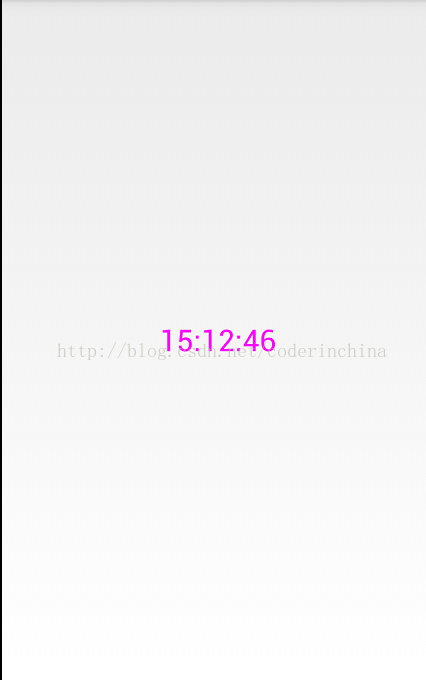在android如果表示数字时针一般用DigitalClock,这个类是google给我们开发者提供的一个方便的类实现数字时针的功能,现在就写个demo,为什么要讲这个类呢?因为我下篇要讲ListView item倒计时功能,所以先把这个基础练习一下,以及它的实现方式,新建android项目digitalClockdemo
布局activity_main.xml文件
<RelativeLayout xmlns:android="http://schemas.android.com/apk/res/android" xmlns:tools="http://schemas.android.com/tools" android:layout_width="match_parent" android:layout_height="match_parent"> <DigitalClock android:id="@+id/digitalClock" android:layout_width="wrap_content" android:layout_height="wrap_content" android:layout_centerInParent="true" android:textSize="25sp" android:textColor="#ff00ff" /></RelativeLayout>
代码都不用写 直接运行起来就会有效果

这个数字是变化的 这只是静态图,为什么代码没写会出来这个效果,所以就得看下他的源码了
public class DigitalClock extends TextView { Calendar mCalendar; private final static String m12 = "h:mm:ss aa"; private final static String m24 = "k:mm:ss"; private FormatChangeObserver mFormatChangeObserver; private Runnable mTicker; private Handler mHandler; private boolean mTickerStopped = false; String mFormat; public DigitalClock(Context context) { super(context); initClock(context); } public DigitalClock(Context context, AttributeSet attrs) { super(context, attrs); initClock(context); } private void initClock(Context context) { Resources r = mContext.getResources(); if (mCalendar == null) { mCalendar = Calendar.getInstance(); } mFormatChangeObserver = new FormatChangeObserver(); getContext().getContentResolver().registerContentObserver( Settings.System.CONTENT_URI, true, mFormatChangeObserver); setFormat(); } @Override protected void onAttachedToWindow() { mTickerStopped = false; super.onAttachedToWindow(); mHandler = new Handler(); /** * requests a tick on the next hard-second boundary */ mTicker = new Runnable() { public void run() { if (mTickerStopped) return; mCalendar.setTimeInMillis(System.currentTimeMillis()); setText(DateFormat.format(mFormat, mCalendar)); invalidate(); long now = SystemClock.uptimeMillis(); long next = now + (1000 - now % 1000); mHandler.postAtTime(mTicker, next); } }; mTicker.run(); } @Override protected void onDetachedFromWindow() { super.onDetachedFromWindow(); mTickerStopped = true; } /** * Pulls 12/24 mode from system settings */ private boolean get24HourMode() { return android.text.format.DateFormat.is24HourFormat(getContext()); } private void setFormat() { if (get24HourMode()) { mFormat = m24; } else { mFormat = m12; } } private class FormatChangeObserver extends ContentObserver { public FormatChangeObserver() { super(new Handler()); } @Override public void onChange(boolean selfChange) { setFormat(); } }}这个类的源码不算多,所以有耐心的全部看完,
首先知道了DigitalClock类是继承此TextView
从构造函数中开始看initClock()方法,代码如下
private void initClock(Context context) {
Resources r = mContext.getResources();
if (mCalendar == null) {
mCalendar = Calendar.getInstance();
}
mFormatChangeObserver = new FormatChangeObserver();
getContext().getContentResolver().registerContentObserver(
Settings.System.CONTENT_URI, true, mFormatChangeObserver);
setFormat();
}
setFormat()方法默认是显示24小时的,最主要的是onAttachedToWindow()方法,
onAttachedToWindow()是挂载在窗体上的 他在activity的onResume()方法之后会执行,
在onAttachedToWindow()方法中关键是这段代码:
mHandler = new Handler();
/**
* requests a tick on the next hard-second boundary
*/
mTicker = new Runnable() {
public void run() {
if (mTickerStopped) return;
mCalendar.setTimeInMillis(System.currentTimeMillis());
setText(DateFormat.format(mFormat, mCalendar));
invalidate();
long now = SystemClock.uptimeMillis();
long next = now + (1000 - now % 1000);
mHandler.postAtTime(mTicker, next);
}
};
mTicker.run();
这是整个类的核心,
mCalendar.setTimeInMillis(System.currentTimeMillis());
setText(DateFormat.format(mFormat, mCalendar));
这二行代码就是显示在我们桌面上的时间 DigitalClock在内部已经实现了,所以为什么我们不用写代码就看到数字时针时间了,
invalidate();没时间变化一次 就会重新绘制UI
long now = SystemClock.uptimeMillis();//从开机到现在的毫秒数(手机睡眠的时间不包括在内);
long next = now + (1000 - now % 1000);
mHandler.postAtTime(mTicker, next);
long next = now + (1000 - now % 1000);这行代码表示没看懂?